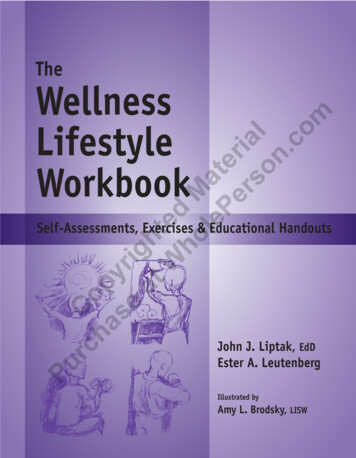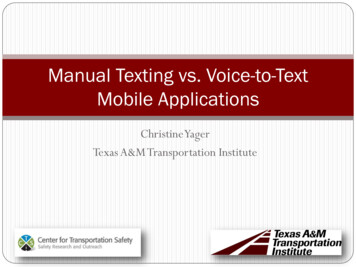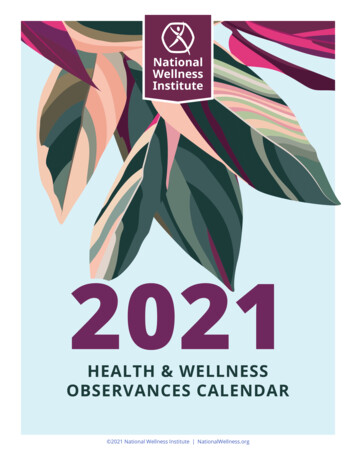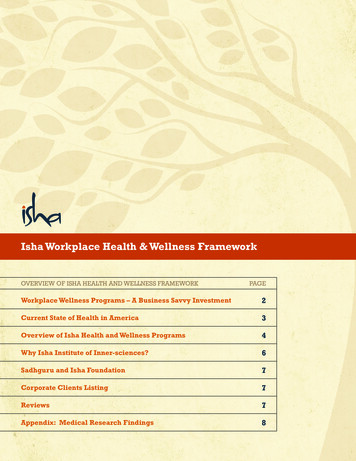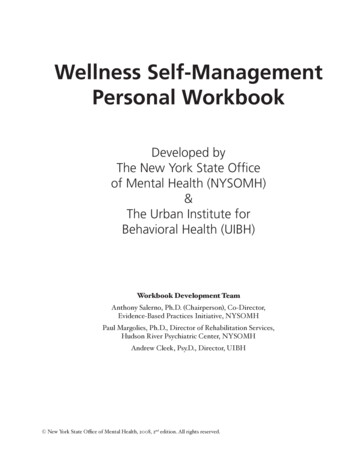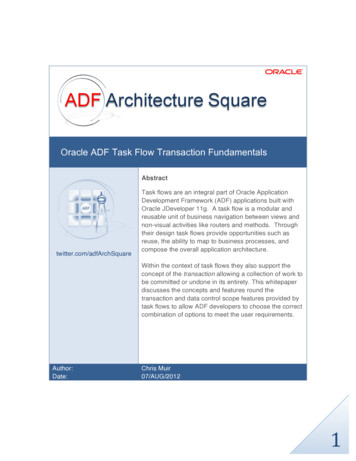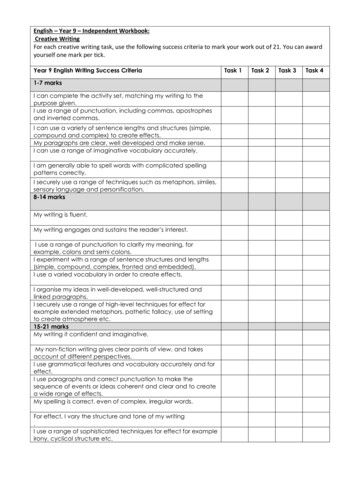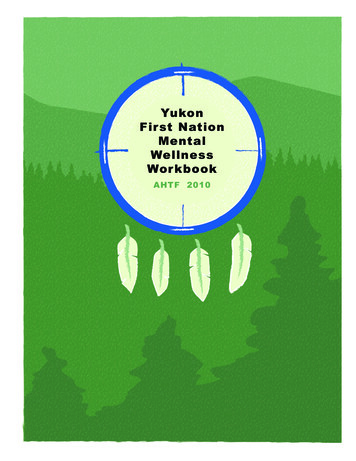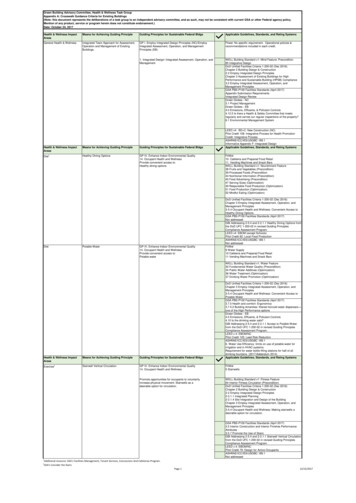
Transcription
Green Building Advisory Committee, Health & Wellness Task GroupAppendix A: Crosswalk Guidance Criteria for Existing Buildings(Note: this document represents the deliberations of a task group to an independent advisory committee, and as such, may not be consistent with current GSA or other Federal agency policy.Mention of any product, service or program herein does not constitute endorsement.)Date: October 24, 2017Health & Wellness ImpactAreasMeans for Achieving Guiding PrincipleGuiding Principles for Sustainable Federal BldgsApplicable Guidelines, Standards, and Rating SystemsGeneral Health & WellnessIntegrated Team Approach for Assessment,Operation and Management of ExistingBuildings.GP I. Employ Integrated Design Principles (NC)/EmployIntegrated Assessment, Operation, and ManagementPrinciples (EB)Fitwel: No specific requirement. Operational policies &recommendations included in each credit.1. Integrated Design/ Integrated Assessment, Operation, andManagementWELL Building Standard v1: Mind Feature: Precondition85 Integrative DesignDoD Unified Facilities Criteria 1-200-02 (Dec 2016):Chapter 2 Building Design & Construction2-2 Employ Integrated Design PrinciplesChapter 3 Assessment of Existing Buildings for HighPerformance and Sustainable Building (HPSB) Compliance3.2 Employ Integrated Assessment, Operation, andManagement PrinciplesGSA PBS-P100 Facilities Standards (April 2017)Appendix Submission RequirementsIntegrated Design ReviewGreen Globes - NC3.1 Project ManagementGreen Globes - EB4.0 Emissions, Effluents, & Pollutant Controls4.12.5 Is there a Health & Safety Committee that meetsregularly and carries our regular inspections of the property?6.1 Environmental Management SystemHealth & Wellness ImpactAreasMeans for Achieving Guiding PrincipleGuiding Principles for Sustainable Federal BldgsDiet1Healthy Dining OptionsGP IV. Enhance Indoor Environmental Quality14. Occupant Health and WellnessProvide convenient access to:Healthy dining optionsDietPotable WaterGP IV. Enhance Indoor Environmental Quality14. Occupant Health and WellnessProvide convenient access to:Potable waterLEED v4: BD C: New Construction (NC)Pilot Credit 108: Integrative Process for Health PromotionCredit: Integrative ProcessASHRAE/ICC/IES/USGBC 189.1Informative Appendix F: Integrated DesignApplicable Guidelines, Standards, and Rating SystemsFitWel10. Cafeteria and Prepared Food Retail11. Vending Machines and Snack BarsWELL Building Standard v1: Nourishment Feature38 Fruits and Vegetables (Precondition)39 Processed Foods (Precondition44 Nutritional Information (Precondition)45 Food Advertising (Precondition)47 Serving Sizes (Optimization)49 Responsible Food Production (Optimization)51 Food Production (Optimization)52 Mindful Eating (Optimization)DoD Unified Facilities Criteria 1-200-02 (Dec 2016):Chapter 3 Employ Integrated Assessment, Operation, andManagement Principles3-5.4 Occupant Health and Wellness: Convenient Access toHealthy Dining OptionsGSA PBS-P100 Facilities Standards (April 2017)Not addressedGBI Addressing 2-5.4 and 2-2.1.1 Healthy Dining Options fromthe DoD UFC 1-200-02 in revised Guiding PrinciplesCompliance Assessment Program.LEED v4: EBOM (except Schools)Pilot Credit 82: Local Food ProductionASHRAE/ICC/IES/USGBC 189.1Not addressedFitWel9 Water Supply10 Cafeteria and Prepared Food Retail11 Vending Machines and Snack BarsWELL Building Standard v1: Water Feature30 Fundamental Water Quality (Precondition)34 Public Water Additives (Optimization)36 Water Treatment (Optimization)37 Drinking Water Promotion (Optimization)Health & Wellness ImpactAreasMeans for Achieving Guiding PrincipleGuiding Principles for Sustainable Federal BldgsDoD Unified Facilities Criteria 1-200-02 (Dec 2016):Chapter 3 Employ Integrated Assessment, Operation, andManagement Principles3-5.4 Occupant Health and Wellness: Convenient Access toPotable WaterGSA PBS-P100 Facilities Standards (April 2017)3.7.5 Health and comfort: Ergonomics3.7.5.2 Building Amenities: filtered hot/cold water dispensers one of the High Performance optionsGreen Globes - EB4.0 Emissions, Effluents, & Pollutant Controls4.10 Is the drinking water safe?GBI Addressing 2-5.4 and 2-2.1.1 Access to Potable Waterfrom the DoD UFC 1-200-02 in revised Guiding PrinciplesCompliance Assessment Program.LEED v.4: EBOM/NCPilot Credit 105: Lead Risk ReductionASHRAE/ICC/IES/USGBC 189.16. Water Use Efficiency: limits on use of potable water forirrigation and in HVAC systems.Requirement for water bottle filling stations for half of alldrinking fountains. (2017/Addendum 2014)Applicable Guidelines, Standards, and Rating SystemsExercise2Stairwell Vertical CirculationGP IV. Enhance Indoor Environmental Quality14. Occupant Health and WellnessFitWel5 StairwellsPromote opportunities for occupants to voluntarilyincrease physical movement: Stairwells as adesirable option for circulation.WELL Building Standard v1: Fitness Feature64 Interior Fitness Circulation (Precondition)DoD Unified Facilities Criteria 1-200-02 (Dec 2016):Chapter 2 Building Design & Construction2-2 Employ Integrated Design Principles2-2.1.1 Integrated Planning2-2.1.4 Site Integration and Design of the BuildingChapter 3 Employ Integrated Assessment, Operation, andManagement Principles3-5.4 Occupant Health and Wellness: Making stairwells adesirable option for circulation.GSA PBS-P100 Facilities Standards (April 2017)3.5 Interior Construction and Interior Finishes PerformanceAttributes3.5.7 Promote the Use of StairsGBI Addressing 2-5.4 and 2-2.1.1 Stairwell Vertical Circulationfrom the DoD UFC 1-200-02 in revised Guiding PrinciplesCompliance Assessment Program.LEED v.4: EBOM/NCPilot Credit 78: Design for Active OccupantsASHRAE/ICC/IES/USGBC 189.1Not addressed12Additional resource: GSA’s Facilities Management, Tenant Services, Concessions And Cafeterias Program.GSA's Consider the StairsPage 112/15/2017
ExerciseExerciseExerciseActive WorkstationsAccess to Fitness CentersAccess to Bicycle Commuter FacilitiesGP IV. Enhance Indoor Environmental Quality14. Occupant Health and WellnessPromote opportunities for occupants to voluntarilyincrease physical movement: Active workstationsGP IV. Enhance Indoor Environmental Quality14. Occupant Health and WellnessPromote opportunities for occupants to voluntarilyincrease physical movement: Fitness centersGP IV. Enhance Indoor Environmental Quality14. Occupant Health and WellnessPromote opportunities for occupants to voluntarily increasephysical movement: Bicycle commuter facilitiesFitWel7 WorkspacesWELL Building Standard v1: Fitness Feature71 Active Furnishings (Optimization)DoD Unified Facilities Criteria 1-200-02 (Dec 2016):Chapter 2 Building Design & Construction2-2 Employ Integrated Design Principles2-2.1.1 Integrated Planning2-2.1.4 Site Integration and Design of the BuildingChapter 3 Employ Integrated Assessment, Operation, andManagement Principles3-5.4 Occupant Health and Wellness: Active WorkstationsGSA PBS-P100 Facilities Standards (April 2017)Not addressedGBI Addressing 2-5.4 and 2-2.1.1 Active Workstations fromthe DoD UFC 1-200-02 in revised Guiding PrinciplesCompliance Assessment Program.LEED v.4: EBOM/NCNot addressedASHRAE/ICC/IES/USGBC 189.1Not addressedFitWel3 Outdoor Spaces8 Shared SpacesWELL Building Standard v1: Fitness Feature65 Activity Incentive Programs (Precondition)66 Structured Fitness Opportunities (Optimization)68 Physical Activity Spaces (Optimization)70 Fitness Equipment (Optimization)DoD Unified Facilities Criteria 1-200-02 (Dec 2016):Chapter 2 Building Design & Construction2-2 Employ Integrated Design Principles2-2.1.1 Integrated Planning2-2.1.4 Site Integration and Design of the BuildingChapter 3 Employ Integrated Assessment, Operation, andManagement Principles3-5.4 Occupant Health and Wellness: Fitness CentersGSA PBS-P100 Facilities Standards (April 2017)3.7.5 Health and comfort: Ergonomics3.7.5.2 Building Amenities: one of the High PerformanceoptionsGBI Addressing 2-5.4 and 2-2.1.1 Access to Fitness Centersfrom the DoD UFC 1-200-02 in revised Guiding PrinciplesCompliance Assessment Program.LEED v.4: EBOM/NCNot addressedASHRAE/ICC/IES/USGBC 189.1Not addressedFitWel2 Building AccessWELL Building Standard v1: Fitness Feature69 Active Transportation Support (Optimization)DoD Unified Facilities Criteria 1-200-02 (Dec 2016):Chapter 2 Building Design & Construction2-2 Employ Integrated Design Principles2-2.1.1 Integrated PlanningChapter 3 Employ Integrated Assessment, Operation, andManagement Principles3-5.4 Occupant Health and Wellness: Bicycle CommuterFacilitiesGSA PBS-P100 Facilities Standards (April 2017)3.7.5 Health and comfort: Ergonomics3.7.5.2 Building Amenities: Locker/changing room BaselinerequirementGreen Globes - EB1.0 Energy1.18 Cycling FacilitiesExerciseMass Transit / Public Transportation Access & GP I. Employ Integrated Design Principles (NC)Walkability1. Integrated Design Principles(Sustainable Locations)LEED v.4 EBOMCredit: Alternative TransportationLEED v.4 BD C: NC and LEED v.4 NDCredit: Bicycle FacilitiesASHRAE/ICC/IES/USGBC 189.15.3.7 Mitigation of Transportation ImpactsFitWel1 Location2 Building AccessWELL Building Standard v1: Fitness Feature67 Exterior Active Design (Optimization)DoD Unified Facilities Criteria 1-200-02 (Dec 2016):Chapter 5 Sustainable Installations5-1 OverviewAppendix B Best PracticesB-1 Promote Sustainable Location and Site DevelopmentB-1.1 Evaluation of SiteGSA PBS-P100 Facilities Standards (April 2017)Chapter 2 Urban Development and Landscape Design2.1 Urban Planning and Public Use PerformanceRequirements2.2.1 Sustainable Locations2.2.1.2 Site Supports Transit-Use and Reduced AutomobileCommuting2.2.1.3 Site Supports Neighborhood Connectivity andWalkabilityGreen Globes - EB1.0 Energy1.17 Public Transportation1.19 Other MeasuresLEED v.4 EBOMSustainable SitesCredit: Alternative TransportationHealth & Wellness ImpactMeans for Achieving Guiding PrincipleAreasSmoking Reduction / Cessation Restrictions on smoking within buildingsGuiding Principles for Sustainable Federal BldgsGP IV. Enhance Indoor Environmental Quality13. Indoor Air Quality(Environmental Smoking Control: Prohibit smoking in anyform within the building and within 25 feet of buildingentrances).ASHRAE/ICC/IES/USGBC 189.15.3.7 Mitigation of Transportation ImpactsApplicable Guidelines, Standards, and Rating SystemsFitWel3 Outdoor Spaces4 Entrances and Ground Floor6 Indoor EnvironmentWELL Building Standard v1: Air Feature02 Smoking BanDoD Unified Facilities Criteria 1-200-02 (Dec 2016):Chapter 3 Employ Integrated Assessment, Operation, andManagement Principles3-5.3.4 Environmental Tobacco Smoke ControlGSA PBS-P100 Facilities Standards (April 2017)Not addressedGreen Globes - EB5.6 Control of Pollutants at SourceGBI Addressing 2-5.4 and 2-2.1.1 Environmental TobaccoSmoke Control from the DoD UFC 1-200-02 in revised GuidingPrinciples Compliance Assessment Program12Additional resource: GSA’s Facilities Management, Tenant Services, Concessions And Cafeterias Program.GSA's Consider the StairsPage 212/15/2017
LEED v.4 EBOMIndoor Environmental QualityEnvironmental Tobacco Smoke Control (Prerequisite)ASHRAE/ICC/IES/USGBC 189.18.3.1.4 Prohibits SmokingAdditional Supportive Occupant Health Attributes related to the Built Environment found in the Guiding PrinciplesHealth & Wellness ImpactAreasMeans for Achieving Potential OutcomeIn addition to other factors,Provide occupant access to daylightexposure to daylightcontributes to resetting ofcircadian rhythms, productionof Vitamin D, and overall wellbeing.Guiding Principles for Sustainable Federal BldgsApplicable Guidelines, Standards, and Rating SystemsGP IV. Enhance Indoor Environmental Quality12. Daylighting and Lighting Controls14. Occupant Health and WellnessFitWel3 Outdoor Spaces7 WorkspacesProvide convenient access to: DaylightWELL Building Standard v1: Light Feature60 Automated Shading and Dimming Controls (Optimization)61 Right to Light (Optimization)62 Daylight Modeling (Optimization)63 Daylighting Fenestration (Optimization)DoD Unified Facilities Criteria 1-200-02 (Dec 2016):Chapter 2 Building Design & Construction2-5.2 DaylightingChapter 3 Employ Integrated Assessment, Operation, andManagement Principles3-5.4 Occupant Health and Wellness: Convenient Access toDaylightGSA PBS-P100 Facilities Standards (April 2017)3.7 Workplace Performance Attributes3.7.4 Health and Comfort: Environmental Controls3.7.4.2 Lighting/Daylighting: employee access to naturaldaylight3.7.6.2 Partitions and interior walls: Maximize natural lightthrough placement & colors6.2 Lighting Performance Attributes6.2.2 Lighting Quantity6.3 Lighting Prescriptive Requirements6.3.1 Indoor Lighting and Daylighting Criteria6.3.2.5 Lighting ControlsGreen Globes - EB5.0 Indoor Environment5.8 Lighting FeaturesGBI Addressing 2-5.4 Convenient Access to Daylight, 2-2.1.1Integrated Planning, and 2-5.2 Daylighting from the DoD UFC1-200-02 in revised Guiding Principles ComplianceAssessment Program.LEED v.4 EBOMIndoor Environmental QualityCredit: Daylight and Quality ViewsASHRAE/ICC/IES/USGBC 189.18.4.1 DaylightingHealth & Wellness ImpactAreasMeans for Achieving Potential OutcomeContribute to improved indoor Provide access to indoor and outdoor plantsair qualityGuiding Principles for Sustainable Federal BldgsApplicable Guidelines, Standards, and Rating SystemsGP IV. Enhance indoor Environmental Quality14. Occupant Health and WellnessFitWel3 Outdoor SpacesProvide convenient access to: PlantsWELL Building Standard v1: Nourishment Feature51 Food Production (Optimization)Mind Feature88 Biophilia I - Qualitative (Precondition)100 Biophilia II - Quantitative (Optimization)DoD Unified Facilities Criteria 1-200-02 (Dec 2016):Chapter 2 Building Design & Construction2-2.1.1 Integrated Planning: include how convenient access toplants is being considered and accommodated from thebeginning of the design process.Chapter 3 Employ Integrated Assessment, Operation, andManagement Principles3-5.4 Occupant Health and Wellness: Convenient Access toPlantsGSA PBS-P100 Facilities Standards (April 2017)Not addressedGBI Addressing 2-5.4 and 2-2.1.1 Convenient Access toPlants from the DoD UFC 1-200-02 in revised GuidingPrinciples Compliance Assessment Program.LEED v.4 EBOMPilot Credit 82: Local Food Production: EBOM Projects (exceptSchools)ASHRAE/ICC/IES/USGBC 189.1Not addressed.Health & Wellness ImpactAreasGuiding Principles for Sustainable Federal BldgsApplicable Guidelines, Standards, and Rating SystemsViews of nature contributing to Provide access to quality exterior viewsoverall well-being and healing(healthcare spaces)GP IV. Enhance Indoor Environmental Quality14. Occupant Health and WellnessProvide convenient access to: Exterior ViewsHealth & Wellness ImpactAreasMeans for Achieving Potential OutcomeGuiding Principles for Sustainable Federal BldgsFitWel7 Workspaces7.2 - Outdoor ViewsWELL Building Standard v1: Light Feature61 Right to Light (Optimization)Mind Feature88 Biophilia I - Qualitative (Precondition)100 Biophilia II - Quantitative (Optimization)DoD Unified Facilities Criteria 1-200-02 (Dec 2016):Chapter 2 Building Design & Construction2-2.1.1 Integrated Planning: include how convenient access toexterior views is being considered and accommodated fromthe beginning of the design process.Chapter 3 Employ Integrated Assessment, Operation, andManagement Principles3-5.4 Occupant Health and Wellness: Convenient Access toExterior ViewsGSA PBS-P100 Facilities Standards (April 2017)3.7 Workplace Performance Attributes3.7.6.2 Partitions and interior walls: Tier 3: Do not blockaccess to views6.2 Lighting Performance Attributes6.2.1 Lighting Quality: 3 Tiers require access to views for 5090% of regularly occupied areasGBI Addressing 2-5.4 and 2-2.1.1 Convenient Access toExterior Views from the DoD UFC 1-200-02 in revised GuidingPrinciples Compliance Assessment Program.LEED v.4 EBOMIndoor Environmental QualityCredit: Daylight and Quality ViewsASHRAE/ICC/IES/USGBC 189.1Not addressed.(Note: Requirements for views of the outdoors have been discussedextensively by the ASHRAE 189.1 Committee, but no proposedrevision has been approved for public review.)Applicable Guidelines, Standards, and Rating SystemsImproved air quality andcontrol of temperatureProvision of ventilation systems, control ofGP IV. Enhance Indoor Environmental Qualitypollutants, IAQ management, and controls for 11. Ventilation and Thermal Comfort: provide safe andoccupant thermal comforthealthy ventilation and thermal comfort.12Means for Achieving Potential OutcomeFitWel6 Indoor Environment7 WorkspacesAdditional resource: GSA’s Facilities Management, Tenant Services, Concessions And Cafeterias Program.GSA's Consider the StairsPage 312/15/2017
WELL Building Standard v1: Air Feature01 Air Quality Standards (Precondition)03 Ventilation Effectiveness (Precondition)05 Air Filtration (Precondition)13 Air Flush (Optimization)14 Air Infiltration Management (Optimization)15 Increased Ventilation (Optimization)17 Direct Source Ventilation (Optimization)18 Air Quality Monitoring and Feedback (Optimization)21 Displacement Ventilation (Optimization)WELL Building Standard v1: Comfort Feature76 Thermal Comfort (Precondition)82 Individual Thermal Control (Optimization)DoD Unified Facilities Criteria 1-200-02 (Dec 2016):Chapter 3 Employ Integrated Assessment, Operation, andManagement Principles3-5 Enhance Indoor Environmental Quality3-5.1 Ventilation and Thermal ComfortGSA PBS-P100 Facilities Standards (April 2017)3.7.4 Health and Comfort: Environmental Controls3.7.4.1 Ventilation and thermal comfort5.2 Mechanical Performance Attributes5.2.1 Temperature5.2.2 Humidity Control5.2.3 Air Movement5.2.4 Pressure5.2.5 Ventilation5.2.6 FiltrationGreen Globes - EB5.0 Indoor Environment5.1 Ventilation System5.6 Control of Pollutants at Source5.7 IAQ ManagementLEED v.4 EBOMIndoor Environmental QualityCredit: Thermal ComfortCredit: Occupant Comfort SurveyCredit: Minimum Indoor Air Quality PerformancePilot Credit: Learning Controls for Thermal ComfortASHRAE/ICC/IES/USGBC 189.18 Indoor Environmental Quality (ASHRAE Standard 62.1,62.2, and 170) & ASHRAE Standard 55Health & Wellness ImpactAreasMeans for Achieving Potential OutcomeGuiding Principles for Sustainable Federal BldgsApplicable Guidelines, Standards, and Rating SystemsImproved air quality andreduce risk of exposure toradon.Test for radon in buildings to mitigate highlevels from occupied spacesGP IV. Enhance Indoor Environmental Quality13. Indoor Air QualityFitWel6 Indoor Environment(Radon: test for radon in buildings and mitigate high levels)WELL Building Standard v1: Air Feature01 Air Quality Standards (Precondition): RadonDoD Unified Facilities Criteria 1-200-02 (Dec 2016):Radon not addressed.GSA PBS-P100 Facilities Standards (April 2017)3.3.3 Substructure: depressurization required when radon ispresent.Green Globes - EB4.0 Emissions, Effluents and Pollution Controls4.7 RadonLEED v.4 EBOMIndoor Environmental QualityRadon not addressedASHRAE/ICC/IES/USGBC 189.1Section 8: Indoor Environmental Quality8.3.4 Isolation of the Building from Pollutants in SoilApplicable Guidelines, Standards, and Rating SystemsHealth & Wellness ImpactAreasMeans for Achieving Potential OutcomeGuiding Principles for Sustainable Federal BldgsImproved air quality andreduce and/or eliminateexposure to mold and mildewProvide policies and strategies for moisturecontrolGP IV. Enhance Indoor Environmental Quality13. Indoor Air Quality(Moisture Control: Establish policy and implement amoisture control strategy to prevent building materialsdamage, minimize mold growth, and reduce associatedhealth risks)FitWel6 Interior Environments6.2 Provide an asbestos-free interiorWELL Building Standard v1: Air Feature06 Microbe and Mold Control (Precondition)12 Moisture Management (Precondition)16 Humidity Control (Optimization)DoD Unified Facilities Criteria 1-200-02 (Dec 2016):Chapter 3 Employ Integrated Assessment, Operation, andManagement Principles3-3 Ventilation Air and Building Envelope Requirements3-5 Enhance Indoor Environmental Quality3-5.3 Indoor Air Quality3-5.3.1 Moisture ControlGSA PBS-P100 Facilities Standards (April 2017)3.2.4 Moisture and Condensate Control3.2.4.1 Moisture Control Opaque Assemblies3.3 Prescriptive Enclosure Requirements3.3.1 Moisture Control3.3.4 Wall Systems3.3.4.2 Materials with Organic Content3.3.4.3 Air/Moisture Barrier System3.5.2.27 Acoustical Ceilings: includes moisture resistanceGreen Globes - EB1.0 Energy1.8 Envelope1.16 Maintenance Schedules5.0 Indoor Environment5.1 Ventilation System5.6 Control of Pollutants at SourceLEED v.4 NCEnergy and AtmosphereCredit: Existing Building CommissioningCredit: Existing Building Commissioning - ImplementationIndoor Environmental QualityCredit: Indoor Air Quality AssessmentHealth & Wellness ImpactAreasMeans for Achieving Potential OutcomeGuiding Principles for Sustainable Federal BldgsImproved air quality andreduction of off-gassing andexposure to VOCsSelection of low-emitting materialsGP IV. Enhance Indoor Environmental Quality13. Indoor Air Quality(Low-Emitting Materials: Use low-emitting materials forbuilding modifications, maintenance, andoperations. In particular, specify the following materials andproducts to have low pollutant emissions: composite woodproducts, adhesives, sealants, interior paints and finishes,solvents, carpet systems, janitorial supplies, and furnishings)12ASHRAE/ICC/IES/USGBC 189.1Section 8: Indoor Environmental Quality8.3.6 Moisture ControlApplicable Guidelines, Standards, and Rating SystemsFitWel6 Indoor Environment6.3 Adopt and implement an Indoor Air Quality (IAQ) policy forthe buildingWELL Building Standard v1: Air Feature01 Air Quality Standards (Precondition)04 VOC Reduction (Precondition)09 Cleaning Protocol (Precondition)25 Toxic Material Reduction (Optimization)26 Enhanced Material Safety (Optimization)DoD Unified Facilities Criteria 1-200-02 (Dec 2016):Chapter 3 Employ Integrated Assessment, Operation, andManagement Principles3-5 Enhance Indoor Environmental QualityGSA PBS-P100 Facilities Standards (April 2017)5.2 Mechanical Performance Attributes5.2.5 Ventilation: 3 tiers include low emitting materialsrequirementsAdditional resource: GSA’s Facilities Management, Tenant Services, Concessions And Cafeterias Program.GSA's Consider the StairsPage 412/15/2017
Green Globes - EB5.0 Indoor Environment5.6 Control of Pollutants at Source5.7 IAQ Management6.0 Environmental Management System6.2 Environmental PurchasingGreen Globes - NC3.7.2 Source Control and Measurement of Indoor PollutantsLEED v.4 EBOMIndoor Environmental QualityCredit: Green cleaning - Products and MaterialsCredit: Indoor Air Quality Management ProgramCredit: Enhanced Indoor Air Quality StrategiesLEED v.4 NCCredit: Low-emitting MaterialsHealth & Wellness ImpactAreasMeans for Achieving Potential OutcomeGuiding Principles for Sustainable Federal BldgsBeneficial indoor air qualitysustained in occupiedbuildings under construction.Control of indoor air quality and impact onoccupants during building alterations ofexisting spaces.GP IV. Enhance Indoor Environmental Quality13. Indoor Air Quality(Indoor Air Quality during Building Alterations: Establish apolicy and implement necessary protocols to protect indoorairquality during renovations, repairs, and alterations, andduring occupancy)Health & Wellness ImpactAreasMeans for Achieving Potential OutcomeReduce chemical exposure as Complete and utilize an integrated pestpart of pest managementmanagement program within buildings.program utilized withinbuildings.ASHRAE/ICC/IES/USGBC 189.1Section 8: Indoor Environmental Quality8.4.2 MaterialsApplicable Guidelines, Standards, and Rating SystemsFitWel6 Indoor Environment6.3 Adopt and implement an Indoor Air Quality (IAQ) policy forthe building.Guiding Principles for Sustainable Federal BldgsWELL Building Standard v1: Air Feature07 Construction Pollution Management13 Air Flush (Optimization)24 Combustion Minimization (Optimization)DoD Unified Facilities Criteria 1-200-02 (Dec 2016):Chapter 2 Building Design & Construction2-5 Enhance Indoor Environmental Quality2-5.3.3 Protect Indoor Air Quality during ConstructionGSA PBS-P100 Facilities Standards (April 2017)Not addressedGreen Globes - EB5.0 Indoor Environment5.6 Control of Pollutants at SourceLEED v.4 EBOMMaterials and ResourcesPrerequisite: Facility Maintenance and Renovation PolicyCredit: Solid Waste Management - Facility Maintenance andRenovationPilot Credit: Clean ConstructionASHRAE/ICC/IES/USGBC 189.1Section 10 Construction and Plans for Operation10.3.1.5 Moisture Control10.3.1.6 Construction Activity Pollution Prevention Idling ofConstruction Vehicles10.3.1.7 Construction Activity Pollution Prevention: Protectionof Occupied SpacesApplicable Guidelines, Standards, and Rating SystemsGP IV. Enhance Indoor Environmental Quality13. Indoor Air Quality(Integrated Pest Management: Use integrated pestFitWel3 Outdoor Spaces3.7 Adoption of an integrated pest management planmanagement techniques as appropriate to minimize pesticideusage)WELL Building Standard v1: Air Feature09 Cleaning Protocol (Precondition)10 Pesticide Management (Precondition)22 Pest Control (Optimization)28 Cleanable Environment (Optimization)DoD Unified Facilities Criteria 1-200-02 (Dec 2016):Chapter 3 Employ Integrated Assessment, Operation, andManagement Principles3-5 Enhance Indoor Environmental Quality3-5.3.3 Integrated Pest ManagementGSA PBS-P100 Facilities Standards (April 2017)2.5 Landscape Prescriptive Requirements2.5.5 Pollinators2.5.5.3 Supplemental Information and Other Considerations2.5.5.3.4 Site Maintenance: includes IPMGreen Globes - EB4.0 Emissions, Effluents and Pollution Controls4.13 PesticidesLEED v.4 EBOMCredit: Integrated Pest Management (IPM)Health & Wellness ImpactAreasMeans for Achieving Potential OutcomeReduce potential exposure and Utilize LCA evaluation of products as a basisrisk to occupants.for product selection.Complete and utilize a Green Purchasingprogram for supplies and products utilizedwithin an existing building.Guiding Principles for Sustainable Federal BldgsASHRAE/ICC/IES/USGBC 189.1Not addressedApplicable Guidelines, Standards, and Rating SystemsGP V. Reduce the Environmental Impact of Materials15. Material Content and PerformanceProcure products and supplies that have a lesseror reduced effect on human health and the environment overtheir life cycle when compared with competing products orservices that serve the same purpose, includingFitWel6 Indoor Environment6.3 Adopt and implement an Indoor Air Quality (IAQ) policy forthe building.6 Indoor Environment6.4 Adopt and implement a Green Purchasing Policyproducts or services that serve the same purpose, including:i. Recycled Content and Comprehensive ProcurementGuidelinesii. Biobased Contentiii. Other Green ProductsWELL Building Standard v1: Air Feature04 VOC Reduction (Precondition)09 Cleaning Protocol (Precondition)11 Fundamental Material Safety (Precondition)26 Enhanced Material Safety (Optimization)Mind Feature97 Material Transparency (Optimization)iv. Ozone Depleting Compounds and High Global WarmingPotential ChemicalsDoD Unified Facilities Criteria 1-200-02 (Dec 2016):Chapter 3 Employ Integrated Assessment, Operation, andManagement Principles3-6 Reduce Environmental Impact of Materials3-6.1.1 Recycled Content3-6.1.2 Biologically-Based Products3-6.1.3 Other Sustainable Products3-6.1.4 Ozone Depleting Substances3-7 Address Climate Change Risk (risk assessment of location& mitigation plan)GSA PBS-P100 Facilities Standards (April 2017)3.4 Interior Performance Requirements: many specificmaterials requirements by building component (recycled,biobased, etc.), too numerous to list5.2 Mechanical Performance Attributes5.2.5 Ventilation: 3 tiers include low emitting materialsrequirements12Additional resource: GSA’s Facilities Management, Tenant Services, Concessions And Cafeterias Program.GSA's Consider the StairsPage 512/15/2017
Green Globes - NC3.5 Materials & Resources3.5.2 Interior Fit-outPath A: Performance Path for Interior Fit-OutsLife Cycle of Interior Fit-OutPath B: Prescriptive Path for Interior Fit-OutsIndustry-wide and/or Product-specific EPDsThird-party certifications based upon multiple attributestandards developed by consensus based process (i.e.NSF/ANSI standards).Third-party certified life cycle product assessment (ISO 14040and 14044)Green Globes - EB6.1 Environmental Managaement System (EMS)Documentation6.1.2 Stated goals and targets in policy?6.1.2.4 Environmental purchasing?6.1.2.5 Reduction in use and proper handling of hazardousproducts?6.1.2.6 Training and education?6.2 Environmental PurchasingNOTE: As part of GBI/ANSI Revision Committee: RiskAssessment for materials is included in the draft.LEED v.4 NCCredit: Building Life-Cycle Impact Reduction Option 3.Building and Material ReuseCredit: Building Product Disclosure and Optimization - EPDsCredit: Building Product Disclosure and Optimization Sourcing of Raw MaterialsCredit: Building Product Disclosure and Optimization - MaterialIngredientsPilot Credit: Legal WoodPilot Credit: Material Ingredients Product Manufacturer SupplyChain OptimizationPilot Credit: Integrative Analysis of Building MaterialsPilot Credit: Building Material Human Hazard & ExposureAssessmentPilot Credit: Certified Multi-attribute Products and MaterialsLEED v.4 EBOMCredit: Purchasing - Facility Maintenance and RenovationCredit: Purchasing - OngoingASHRAE/ICC/IES/USGBC 189.19 The Building's Impact on the Atmosphere, Materials, andResources9.4 Prescriptive Option9.4.1 Reduced Impact Materials9.4.1.1 Recycled Content and Salvaged Material Content9.4.1.2 Regional Materials9.4.1.3 Biobased Products9.4.1.4 Multiple-Attribute Product Declaration or Certification(EPD, NSF/ANSI Standards, Product Life Cycle)9.5 Performance Option9.5.1 Life-Cycle Assessment (LCA)12Additional resource: GSA’s Facilities Management, Tenant Services, Concessions And Cafeterias Program.GSA's Consider th
Oct 24, 2017 · 66 Structured Fitness Opportunities (Optimization) 68 Physical Activity Spaces (Optimization) 70 Fitness Equipment (Optimization) DoD Unified Facilities Criteria 1-200-02 (Dec 2016): Chapter 2 Building Design & Construction 2-2 Employ Integrated Design Principles 2-2.1.1 Integrated Planning 2-2.1.4 Sit

